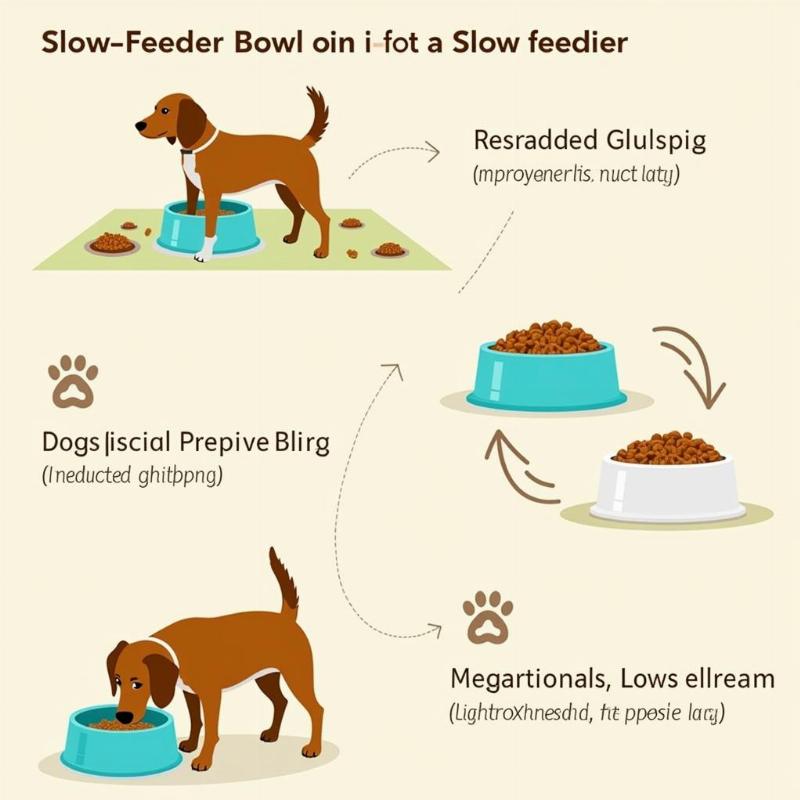Slow feeder stainless steel dog bowls are a popular choice for pet owners looking to improve their dog’s mealtime experience. These specially designed bowls help prevent gulping, promote healthy digestion, and can even offer mental stimulation for your furry friend. But with so many options available, how do you choose the right slow feeder for your dog’s needs? This guide will explore the benefits, features, and selection process for slow feeder stainless steel dog bowls, helping you make an informed decision for your beloved canine companion.
Why Choose a Slow Feeder Dog Bowl?
Many dogs, especially those prone to excitement or competition, tend to inhale their food. This behavior, known as gulping, can lead to a variety of health issues, including vomiting, bloating, and even a life-threatening condition called Gastric Dilatation-Volvulus (GDV). Slow feeder bowls are designed to combat this problem by adding obstacles within the bowl that force dogs to eat more slowly and deliberately. This promotes proper digestion, reduces the risk of digestive upset, and helps your dog feel fuller and more satisfied after meals.
 Benefits of Using a Slow Feeder Dog Bowl
Benefits of Using a Slow Feeder Dog Bowl
The Advantages of Stainless Steel
While slow feeders are available in various materials, stainless steel offers several key advantages. It’s durable, hygienic, easy to clean, and resistant to rust and bacteria growth. Stainless steel bowls are also less likely to harbor odors and allergens, making them a healthier choice for your dog. Moreover, they are dishwasher safe, saving you time and effort.
Choosing the Right Slow Feeder Stainless Steel Dog Bowl
Selecting the appropriate slow feeder depends on several factors, including your dog’s breed, size, eating habits, and any existing health conditions. Consider the following aspects when making your choice:
- Size and Depth: Choose a bowl size that’s appropriate for your dog’s breed and the amount of food they typically eat. A bowl that’s too small can frustrate your dog, while one that’s too large can defeat the purpose of slowing down their eating.
- Obstacle Design: Different slow feeders feature different obstacle designs, ranging from simple ridges and bumps to more intricate mazes and puzzles. Observe your dog’s eating habits to determine the level of challenge they need. dog bowls that slow eating
- Non-Slip Base: A non-slip base is essential to prevent the bowl from sliding around while your dog eats, minimizing messes and frustration.
- Ease of Cleaning: Opt for a bowl that’s easy to disassemble and clean thoroughly to maintain hygiene.
How Slow Feeders Benefit Your Dog’s Mental Health
Beyond the physical benefits, slow feeder bowls can also provide mental stimulation for your dog. The challenge of navigating the obstacles can engage their problem-solving skills and provide a more enriching mealtime experience. This can be especially beneficial for dogs prone to boredom or anxiety. slow eating food bowls for dogs
Are Slow Feeders Right for Every Dog?
While slow feeders are beneficial for many dogs, they may not be suitable for all. Brachycephalic breeds (those with short noses, like Bulldogs and Pugs) may have difficulty eating from certain slow feeder designs. Senior dogs with dental issues or decreased appetite may also struggle. Consult with your veterinarian if you have any concerns about whether a slow feeder is appropriate for your dog. flat feeding plate for dogs
Conclusion
Slow feeder stainless steel dog bowls offer a simple yet effective way to improve your dog’s mealtime experience and overall well-being. By promoting slower eating, these bowls can help prevent digestive issues, encourage healthy eating habits, and even provide mental enrichment. Carefully consider your dog’s individual needs and choose a bowl that’s the right size, design, and material for their comfort and enjoyment. how to slow a dog down while eating
FAQ
- How do I clean a stainless steel slow feeder bowl? Most stainless steel slow feeders are dishwasher safe, making cleaning a breeze. Hand washing with warm soapy water is also effective.
- What if my dog doesn’t like the slow feeder? Introduce the slow feeder gradually. Start by mixing their regular bowl with the slow feeder to help them adjust.
- Can puppies use slow feeders? Yes, slow feeders can be beneficial for puppies, especially those prone to gulping.
- Are there different sizes of slow feeders available? Yes, slow feeders come in a variety of sizes to accommodate dogs of all breeds and sizes.
- What are the signs that my dog is eating too fast? Common signs of gulping include choking, gagging, vomiting, and regurgitation.
- My dog tips over his slow feeder. What can I do? Look for a slow feeder with a non-slip base to prevent tipping. dog food feeder and storage
- How often should I replace my dog’s slow feeder? Replace the bowl if it becomes damaged or shows signs of excessive wear and tear.
Beautdogs.us is your premier resource for all things dog-related in the US. We offer expert advice on dog breeds, care, and products, empowering you to provide the best possible life for your furry companion. Whether you’re a seasoned dog owner or just starting your journey, Beautdogs.us is your trusted source for comprehensive and engaging information. Contact us at [email protected] or +1 501-555-7529.